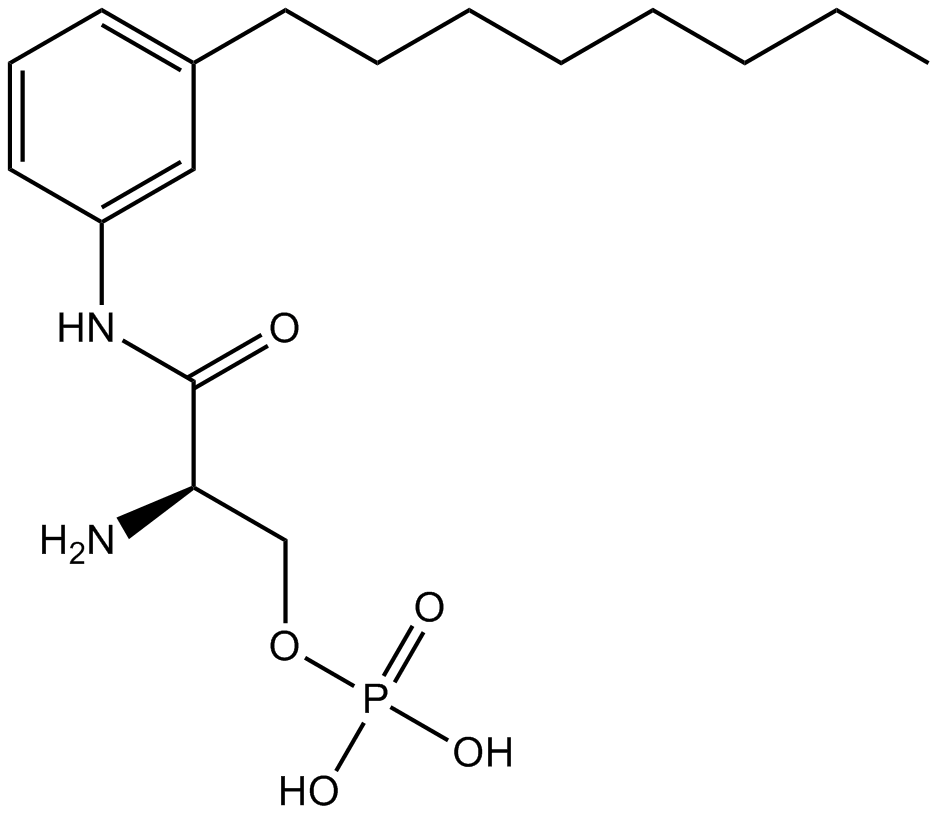VPC 23019 |
| Catalog No.GC15694 |
S1P1/S1P3 receptor antagonist
Products are for research use only. Not for human use. We do not sell to patients.

Cas No.: 449173-19-7
Sample solution is provided at 25 µL, 10mM.
VPC 23019, phosphoric acid mono-[2-amino-2-(3-octyl-phenylcarbamoyl)-ethyl] ester, is an S1P1/S1P3 receptor antagonist. S1P is short for sphingosine-1-phosphate [1]. VPC 23019 abolished S1P-induced, cell migration, Gi-dependent Rac stimulation and tube formation [2]. VPC 23019 inhibited SIP1 activity with an IC50 value of 8 nM [3].
S1P can act on specific G protein-coupled receptors. 5 subtypes of these receptors have been found and termed S1P1–5. These receptors couple to intracellular second messenger systems including intracellular Ca2+, phospholipase C, adenylyl cyclase, phosphatidylinositol 3 (PI3)-kinase, mitogen-activated protein kinases, protein kinase Akt, and Ras- and Rho-dependent pathways [1].
In the bEnd.3 cell line, VPC 23019 did not affect basal NO production. Preincubation with 10 µmol/L VPC 23019 made Ang II–induced NO production decrease to approximately basal level [1]. S1P, in a dose-dependent manner, stimulated trans-well migration of mouse vascular endothelial cells with a peak response at 10-7M. VPC 23019 was able to abolish this stimulatory effect of S1P [2]. Preincubation with 10 µM of VPC 23019 partially inhibited S1P-induced calcium increase in L2071 cells [4].
In rat, VPC 23019 significantly increased the S1P-induced vasoconstriction in preparation with intact endothelium (P< 0.01), but did not change it in preparation without endothelium. In intact mouse basilar artery (relaxation to ACh, 45.6±7.2%, n= 16), VPC 23019 left-shifted the concentration-contraction curve to S1P by a half log. VPC 23019 did not modify contractile responses to 5-HT, KCl or U46619 [5].
References:
[1]. Arthur C.M. Mulders, Mariëlle C. Hendriks-Balk, Marie-Jeanne Mathy, et al. Sphingosine Kinase-dependent Activation of Endothelial Nitric Oxide Synthase by Angiotensin II. Arterioscler Thromb Vasc Biol., 2006, 26:2043-2048.
[2]. Isao Inoki, Noriko Takuwa, Naotoshi Sugimoto, et al. Negative regulation of endothelial morphogenesis and angiogenesis by S1P2 receptor. Biochemical and Biophysical Research Communications, 2006, 346: 293-300.
[3]. Ju Wang, Zi-Qi Shi, Xiaojun Xu, et al. Triptolide Inhibits Amyloid-β Production and Protects Neural Cells by Inhibiting CXCR2 Activity. Journal of Alzheimer’s Disease, 2013, 33:1-2.
[4]. Mi-Kyoung Kim, Kyoung Sun Park, Hyuck Lee, et al. Phytosphingosine-1-phosphate stimulates chemotactic migration of L2071 mouse fibroblasts via pertussis toxin-sensitive G-proteins. Exp. Mol. Med., 2007, 39(2):185-194.
[5]. S Salomone, EM Potts, S Tyndall, et al. Analysis of sphingosine 1-phosphate receptors involved in constriction of isolated cerebral arteries with receptor null mice and pharmacological tools. British Journal of Pharmacology, 2008, 153:140-147.
Average Rating: 5 (Based on Reviews and 24 reference(s) in Google Scholar.)
GLPBIO products are for RESEARCH USE ONLY. Please make sure your review or question is research based.
Required fields are marked with *




















